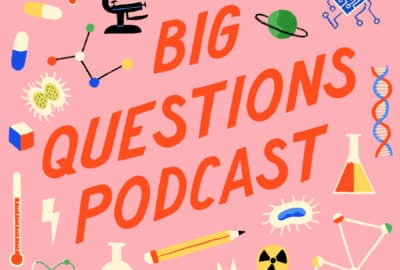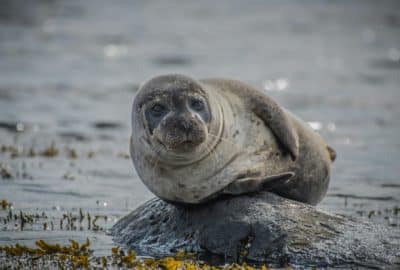Is ordering a pizza bad for the climate?
Wednesday 23rd Feb 2022, 12.30pm
In this episode of the Big Questions podcast, we’re talking about one of our favourite guilty pleasures – ordering a pizza! From the machinery required to harvest the wheat for the dough, to the cardboard packaging your finished pizza is delivered in, we’re considering all aspects of a pizza’s journey and asking: is ordering a pizza bad for the climate? Environmental scientists Eleanor Hammond and Dr Mike Clark are here to provide some answers, and tell us about ‘4 steps 4 the Earth’. (Don’t worry, they’re not banning pizza!)
Emily Elias: We’ve all been there. It’s dark, it’s cold, we’ve had a long day, and we just want someone to bring us pizza, but then there’s that little whisper of guilt. On this episode of the Oxford Sparks ‘Big Questions’ Podcast, we’re asking: is ordering a pizza bad for the climate?
Hello, I’m Emily Elias, and this is the show where we seek out the brightest minds at the University of Oxford and we ask them the big questions. For this one, we’ve got a two-for-one deal: a duo of researchers looking at food and the environment.
Mike Clark: Hi, I’m Mike Clark. I’m a researcher based in the Nuffield Department of Population Health in the Oxford Martin School, and my research focuses mostly on the intersection between food, health, and environment.
Eleanor Hammond: I’m Eleanor Hammond, and I’m a research assistant at Zoology. My research focuses on how to measure the impacts of food and how to reduce these impacts, working with caterers in canteens.
Emily: You guys work in two different departments. Why have you guys come together?
Mike: Yes, we’re collaborating because we’re doing, or we focus, on slightly different aspects of food sustainability. What I’ve been working on is I’ve been trying to sort out a way that’s standardised and fairly robust, to estimate the environmental impacts, so greenhouse gas emissions, biodiversity, water, land use, of the foods that we interact with, and the foods that we purchase and consume.
Eleanor: Then I’m trying to take this research and understand how people will be able to use this information to actually make a difference in their own lives. We’re specifically trying to work out how to build this into some kind of web tool. For example, this could be for people who are in catering, so how can they reduce the environmental impact of their food that they’re selling? But also individuals, so how can an individual like you and I make a difference in our day-to-day food consumption?
Emily: What kind of difference could having this easy-to-use web tool, or app, make in our food choices?
Eleanor: This web tool would enable caterers to measure their baseline food-related environmental impacts. This would allow them to understand how the changes that they could make would then translate to an environmental benefit.
Mike: I think, building off what Eleanor said, one other important thing to notice is that really large catering organisations, so Compass, which is the one that does most of the food at Oxford’s departmental cafés and a lot of the food retailers in the UK, so Tesco’s and Sainsbury’s, are starting to set their own environmental targets. So, we’re trying to hit the intersection of both something that we’re both really excited to work on but also something that people are going to need to use in both the short term and, hopefully, long term too.
Emily: Okay, so I came to you guys with a bit of a question. I’m sitting there on a Tuesday. I don’t want to cook for myself. I just want to order a pizza and make that problem go away of, “What am I going to have for dinner?” So, I asked you – dun, dun, dun – how bad is it if I just go and order a pizza and get it sent to my house? How would you go about measuring the carbon footprint of foods and other…? And pizzas and all that sort of stuff.
Mike: That’s a really important question, and it’s a really long question to answer. I’ll keep it short. The general way that we do this is something called ‘lifecycle assessments’ and so those are shortened to ‘LCAs’. LCAs are a way to measure the impacts of, in this case, food production systems, based on inputs going into those – say, farms.
An example of this is that, from producing wheat to go into the dough that then goes in the pizza, you would say, “What fertiliser inputs, what energy use, what type of machinery, what type of diesel to run that machinery is used to create and grow wheat?”
Based on those inputs and how many outputs you get, you can say, “These are the impacts of those inputs.” So, by combining those inputs and outputs, you get a general idea of what, for instance, the greenhouse gas emissions per kilogramme of wheat produced might be. You can do the same thing for other types of foods, so do it for maize, do it for poultry, do it for beef and so on.
When you start looking at other foods, it becomes a little bit more complicated. The reason for that is that, specifically if you look at livestock systems, we’re in many cases not just growing wheat for us to produce, but we’re growing wheat, or maize, or soybeans for cows to eat. The cows eat those crops and produce food that we then eat. So, it’s the same process, with just one additional step or two additional steps.
Emily: Let’s focus in on pizza as our key example here. Mike, you’ve alluded to a bit about the flour, but, Eleanor, what else is going on behind the scenes for that doughy base to get to my table?
Eleanor: One important thing to note is that, when people think about the environmental impact of food products, they quite often just focus on the carbon footprint, but there are other important factors.
We’re quite interested in the biodiversity impact of food products. ‘Biodiversity’ is a term we used to describe nature, wildlife, and that kind of thing. So, in addition to carbon footprint that is associated with the dough, there are also other features that would affect what we call ‘biodiversity’. That would be land use, water use, the use of toxic chemicals, because these all affect the natural world.
The reason that we care so much about this is because nature and wildlife have quite an important role in regulating the planet that we live on. For example, they are involved in weather regulation and, for example, pollination. Toxic chemicals would affect pollinators, such as bees. That’s important for sustaining other food production, so that’s why we’re interested in that.
Emily: So, then, when we’re looking at a pizza and getting into more ingredients outside of the dough, what do you have to take into consideration when you’re looking at the carbon footprint of something like that?
Mike: If you’re looking at all the ingredients that go into a pizza, so it might be the pizza dough, so flour, water, salt, yeast, and so on. Then you have the sauce. You may or may not have cheese. You might have vegetables. You may or may not have meat.
If you look at it from all those ingredients’ perspective, you take the same approach that both Eleanor and I spoke about earlier to measure the impacts of any one of those ingredients, at a relatively broad scale what you’re going to get is the pizza dough, and the pizza sauce and the vegetables on the pizza don’t account for a particularly large proportion of the pizza’s total impact. But when you start talking about cheese – especially hard cheeses, like Parmesan or Cheddar, if you put Cheddar on a pizza – and then meat, and especially beef, you start getting towards ingredients that contribute a larger proportion of impact.
On a unit-by-unit basis, the reason that this happens is that cheese has a moderate to high impact, compared to vegetables, and wheat, and legumes, whereas most meats – and especially beef, and sheep, and goat meat – have a much higher impact per kilogramme, or per gramme of protein, or per 100 calories, than does cheese, than do fruits, vegetables, cereals, and most legumes.
Emily: What about the other factors that go into a pizza? It comes in a box. It gets delivered to me by a driver who’s probably, maybe, not on a bicycle, maybe some petrol being burned. How does that also factor into when you make a calculation of the carbon footprint of that food item?
Mike: You can do the same general process. So, if you’re thinking about transportation and you have somebody driving, say, 10 kilometres from the pizzeria to your house, you can say, “How much fuel does this transportation take? What is the climate impact and the biodiversity impact of burning that fuel?” You can do the same thing for carbon packaging or plastic packaging.
Emily: We’ve got all these things at play. On the grand scale of, “Is it bad for me to order a pizza?” where does this stack up? Am I a terrible person for ordering a pizza?
Eleanor: The short answer to that is no, because not all pizzas are made equal. If you were trying to think about ways to reduce your environmental impact while still ordering a pizza, you can think of it in a four-step framework. We call it ‘Four Steps for the Earth’.
The first step is refrain. You can refrain from the most environmentally impactful ingredients some of the time. So, it doesn’t mean you have to change your pizza order all of the time, but, for example, if you usually go for a ‘meat fest’ pizza, you could maybe order a chicken pizza half of the time, because poultry has a lower environmental impact than red meat, for example. Or, if you usually have a chicken pizza, then you could have a vegetable pizza half the time.
That was one step you can do, and then the next step would be to reduce some of the environmental impact of your pizza. For example, if you usually have a chicken pizza, you could try and find a pizza that has half chicken, half vegetables, so that you still have your chicken pizza but it has just got half of the chicken. That will reduce some of the impact because vegetables, as Mike was saying, have a lower environmental impact than chicken, for example.
Or another way to reduce your environmental impact would be to try and have a pizza that’s sourced a bit more sustainably, so the ingredients come from farms or supply chains that have a lower environmental impact.
For example, if your pizza had fish on it – so, sometimes pizzas have anchovies – you could look to order a pizza that the anchovies are certified with a label called ‘MSC’. So, Marine Stewardship Council, which means that the fishing practices that are used to source that ingredient are more sustainable than if they didn’t have that certification label.
Then, on top of that, you could try not to order too much pizza, so only order what you’re going to eat. Or, if you do order too much pizza, try and do something useful with the food waste, so, for example, composting or having it for lunch the next day.
Then the fourth step you can do is we call it ‘renew’, so you can renew some of the environmental impact. This is thinking about how to make up for some of the negative environmental impacts by investing in positive actions elsewhere. So, for example, if you’ve got a garden, you could try and plant flowers to encourage pollinators, because this promotes biodiversity elsewhere and tries to make up for some of the negative impacts that might have come from your pizza.
Emily: Do you think people are going to be willing to change their behaviour to try and make better choices for the environment?
Eleanor: I think yes because I’m an optimist. I think one of the reasons I say, “Yes” is because making more informed decisions about what toppings you might get on your pizza, for example, keeping in the pizza context, no longer has to mean that you miss out on taste, for example. Because nowadays, as more and more people are aware of the environmental impact of their food choices, that translates into companies having more and more options that are more environmentally sustainable. So, you can still have a tasty pizza whilst also not being quite so impactful on the planet.
Mike: From a very broad perspective, one of the reasons why we’re talking about food, and in this case pizza, is that, if we look at all greenhouse gas emissions, about 30% to 35% of all greenhouse gas emissions are resulting from activities within the food system. That includes, essentially, how we produce food, what we eat, and everything in between.
There’s a decent amount of evidence that very, very strongly suggests that, if we don’t change our eating habits, we’ll miss the climate targets, we’ll miss the biodiversity targets. We’ll probably miss water, and land, and fish sustainability targets, too.
The thing is that isn’t only on environmental perspectives, too. If you look at major drivers of poor nutrition and poor health, roughly about 10 of the top 15 risk factors for mortality from any sort result from food choices. Sometimes it’s eating too much. Sometimes it’s not having enough food.
From those two perspectives – the environmental perspective and the health perspective – yes, I’m really hopeful that people are willing to start considering the impact that their food has on themselves and on the planet, because if we don’t start making choices on food and try to be a little bit more aware, then we’re really going to be in an even worse place than we are right now.
Emily: I don’t want to get you guys in trouble with your supervisor, because obviously deadlines are deadlines, are deadlines. We’re not trying to forecast of when you’ll have all your work done, (Laughter) but what’s the timeline you have attached to creating this tool that people could start plugging in their meals, their pizzas, their fried chickens, and seeing how much it has an impact on the planet?
Eleanor: One thing to note is that Mike’s an absolute whiz. Already there, there might be, on the short-term horizon, what we call ‘eco labels’ in restaurants, or cafeterias, or supermarkets. So, you might be able to look at a food product and actually be able to see what the environmental impact of that food product might be.
That could be quite soon, so that’s really cool. In terms of how this kind of idea would be built into some kind of interactive tool, hopefully soon. I guess ‘soon’ is probably the best word to use.
Mike: Yes, thanks, Eleanor. I think it’s also good to mention that Eleanor has been absolutely brilliant. We’ve been working on this project for about 2½ months now. It has gone from, essentially, conceptualisation to actually Eleanor is already talking with focus groups and Compass in catering organisations and college canteens to, essentially, get buy-in, and has gotten a lot of people very, very interested in this.
So, yes, as you were saying, it’s hard to say exactly what timelines are going to be, but it’s going really, really quickly. That’s mostly because Eleanor has been absolutely fantastic getting all of these bits and pieces from different places and organising them into one really big and really challenging project.
Emily: This podcast was brought to you by Oxford Sparks, from the University of Oxford, with music by John Lyons and a special thanks to Mike Clark and Eleanor Hammond. Find us on social media. We are ‘@OxfordSparks’, and you can also check out our fancy new website, ‘oxfordsparks.ox.ac.uk’. I’m Emily Elias. Bye for now.
Transcribed by UK Transcription.





